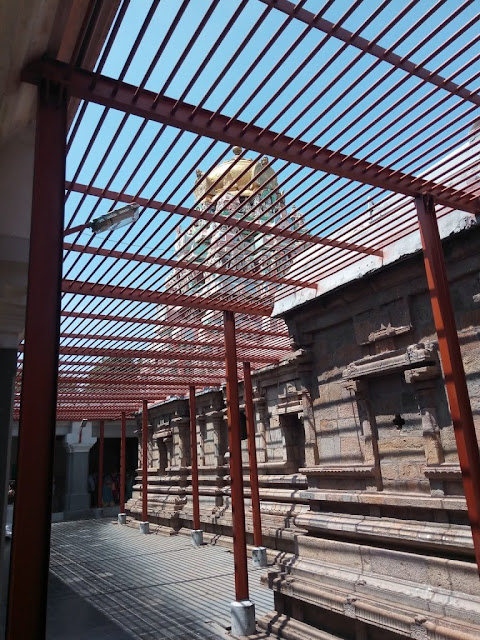Uppiliappan Temple,
Tirunageswaram – The Temple
This east facing temple has 50
feet high five-tiered Rajagopuram (the gateway tower) and enshrined
within a granite wall. The complex contains all the shrines and water bodies
associated with it. The Temple has two
prakarams. Dwajastambam, Bali Peedam and eight pillared mandapam can be seen
behind Garuda Shrine. The area for Pradakshinam has many beautiful paintings of
Dashavatara. It has got Gosala and garden also. There is a beautiful Temple
elephant which is decorated during festival occasions.
Sanctum:
The main shrine of the temple
houses the image of Oppiliappan in standing posture and it also houses the
images of Bhumidevi and sage Markandeya. Presiding Deity stands majestically
facing east. He is about 8 feet tall. His consort Bhumidevi is seated with a
bending knee and folded hands facing north. Markandeya is seated facing south
in a posture indicative of giving Kanya - Dhan. Left hand of Oppiliappan
contains the inscription "Maam Ekam Saranam Vrija" made of diamonds
which is a verse form Bhagavad-Gita instructing the whole mankind to devote
their pure souls into his lotus feet to attain Salvation.
The vimana over the
sanctum is called as Suddhananda Vimanam (Suddhananda meaning pure happiness).
It is plated with gold. Note that the vimana in Tirumala Tirupati is named
as Ananda vimana, whereas here it is Suddhananda Vimana. It is believed that
Lord Vishnu granted darshan to Nammazhvar in five forms – Tiruvinnagarappan (in
sanctum sanctorum), Ponnappan (procession deity), Maniappan and Ennappan in Prakara
shrines and Muthappan. Of these, Muthappan shrine is not in
existence. Discus and Conch are with the Lord in Maniappan shrine.
The utsava deity Oppiliappan is
never taken out of the temple, without his consort, Bhumidevi. The Sahasradhari
plate and pot (Kudam) are made of gold for
performing Thirumanjanam (ablution) to the presiding deity. The
temple also maintains golden sword, diamond crown and gold arm guard for the
image of Hanuman. All food offerings at the temple are strictly and completely
saltless. Salt or any food item containing salt is not allowed in the temple
beyond Garuda’s Sannidhi. It is a sin to carry salt inside the temple. Hence
the Lord is also called as ‘Lavana Varjita Venkatesa’ i.e. Venkatesa who avoids
salt.
Other Shrines:
The Desika shrine is located
near the sanctum sanctorum. On the sides of the first precinct, the shrine of
Anjaneya is located on the southern, and Alwars and Sri Rama on the northern
and Ramanuja on the eastern sides. The shrine for Maniappan is located in the
second precinct in the southern side, while the shrines of Ennappan and the
holy birth spot of Bhumidevi are located in the northern side. Garuda's shrine
is located right opposite the sanctum and right behind the temple mast. The
shrine of dancing Krishna is located on the southern side of the main entrance.
Mandapams:
A marble hall is located on the
western side in the inner precinct acts as the resting hall for the festival
deities during festivals. Dolothsavam festival is celebrated in another marble
hall in the northern side of the temple. Adjoining the hall, there is a shrine
where the images of Rama, Lakshmana, Sita and Hanuman are housed. The sacred
bed chamber called Tiruppalliarai, covered full of mirrors is located next to
it, where during festivals, the Lord and his consort rest during nights. During
the two Brahmotsavams in Panguni (March-April) and Purattasi (Sept-Oct), it is
a divine sight to watch and worship the god and goddess in this room full of
mirrors.
Yaga Sala:
A Yaga Sala for performing
religious rituals is present in the temple.
Vahana Mandapam & Library:
The temple includes a vahana
mandapa and a library. Vahana Mandapam is used to house Vahanas of Lord.
Religious books are preserved in this Library.
Eight Pillared Hall:
A hall with eight carved pillars
is located on the banks of the temple tank (Pushkarini), where the annual
float-festival is celebrated during January - February.
Kodimandapam:
The Kodimandapam, located to the
south of the Garuda shrine, is used for several day-to-day religious practises.
The annual Kalyana Utsavam festival is performed in the hall amidst music and
dance programmes. Prarthana Kalyana Utsavams are also performed here.
Marriage Halls:
Outside the main complex, the temple maintains two huge marriage halls where marriages tec., can be conducted
for a nominal fee.
Rest House:
There is also a rest house
containing 5 rooms, which is available for use by pilgrims at cheap rent.
Chariot Halls:
There are 2 mandapas at the end
of the Sannidhi Street. One houses a small chariot and the other for use during
the big chariot festival.
Gardens:
There is a garden around the
third precinct of the temple and a much bigger garden about 0.5 km
(0.31 mi) to the south of the temple, where Tulasi and flowers are grown
in abundance for weaving garlands daily for the deities. A hall in the garden
is used for resting deities during the Vasantotsavam festival celebrated for
six days in May–June every year.
Thulabharam:
There is a small 'Thulabharam'
to the right side before you enter the sanctum sanctorum. Devotees can offer
anything as per their vow except salt.
Sthala Vriksham:
Sthala Vriksham is Tulsi.
Theerthams:
For brief details, please refer
below link;
Inscriptions:
There are inscriptions
from Medieval Cholas period indicating generous gifts to the temple.
There are two inscriptions recorded from the Naganatha Swamy Temple in Tirunageswaram. The inscriptions on the northern wall of
the central shrine indicates gift of gold jewel worked in gems and pearls to
the temple from the Chola king Parakesarivarman alias Rajendra Chola
I (1012–44 CE). The second inscription on the southern wall of the same
shrine indicates a gift of land to the temple in the fourteenth year of the
Chola king Rajaraja Rajakesarivarman I. Inscriptions refers the place as Thiruvinnagar
– Tirunageswaram and Uyyakondar Valanaadu.














